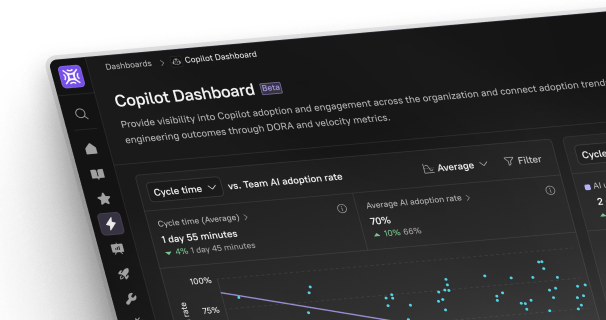It's 2 a.m. and your engineering team is sound asleep when suddenly a barrage of alerts start flooding in. A critical service is down and customers are complaining. Your developers scramble to sift through the noise, identify the root cause, and fix the issue—all while racing against the clock to meet tight SLOs.
Sound familiar? Any team running a critical cloud service has run into a similar situation at some point. In this type of scenario, incident response automation can be a game-changer. By streamlining and automating key parts of the incident management process, developers can resolve issues faster and more efficiently. In this article, we'll dive into what incident response automation is, how it works, best practices to follow, and how tools like Cortex can help.
What is incident response automation?
Incident response automation is the practice of using technology such as AI, machine learning, and pre-configured workflows to automatically detect, investigate, and remediate incidents with minimal human intervention. The goal is to improve production readiness by automating repetitive tasks, allowing teams to respond faster and more efficiently to various IT issues.
Some ways to automate incident responses include:
Alert triaging and routing: By using predefined rules and machine learning algorithms, the incident management system can automatically assess the severity of alerts, filter out false positives, and route incidents to the appropriate response teams or on-call responders.
Containment and remediation: Automated incident response tools can execute predefined containment actions immediately upon detection of a threat. This may include automatically isolating affected systems, revoking compromised credentials, or deploying patches.
Compliance and audit logging: The incident management workflow can be configured to automatically capture and store all actions taken during an incident, ensuring a complete audit trail without burdening responders with manual documentation tasks.
Security testing and scanning: Automated security scanning tools can continuously monitor systems for vulnerabilities, misconfigurations, or potential threats and proactively identify and address security issues.
Recovery and reporting: Automation can assist in the recovery process by executing predefined runbooks for system restoration and data recovery. Additionally, automated reporting tools can generate comprehensive incident reports.
The automation for these processes can be integrated into the existing incident response process and development workflows, including monitoring dashboards and CI/CD pipelines so that they are adopted smoothly into the architecture. Automation allows organizations to significantly reduce response times, minimize human error, and free up their technical teams to focus on more complex, high-value tasks. In fact, 50% of engineering leaders surveyed mentioned automation and continuous integration/deployment as key to their production readiness.
Incident response automation use cases
Automation can significantly speed up incident responses in the following scenarios:
Time-critical incidents: For major outages or security breaches where every minute counts, automation can execute containment actions immediately, such as isolating affected systems or rolling back problematic code changes.
Routine incidents: Low-priority issues that occur frequently can be partially or fully automated to eliminate toil and free up developers to focus on higher-impact work. For example, automatically restarting services or clearing disk space when certain thresholds are exceeded.
Data collection and analysis: Automation can help centralize data from multiple monitoring tools, filter out irrelevant alerts, and correlate events to provide a cohesive picture of the incident. This automation layer can help developers quickly pinpoint root causes.
How does incident response automation work?
At a high level, incident response automation uses predefined rules, scripts, and integrations to automatically handle certain incident management tasks. Both security teams and development teams have important roles to play in these steps, and we’ll address both.
Define and integrate
The incident management process begins with defining the automation strategy and integrating it into existing workflows. Security teams develop a comprehensive incident response plan, identifying time-consuming manual tasks prime for automation, often based on previous incidents or common issues. Security and development teams create playbooks and runbooks that outline step-by-step automated processes for various use cases, ensuring alignment with SLAs and cybersecurity and engineering best practices.
Teams may choose to integrate with a few different systems. One option is using a security information and event management (SIEM) tool. While often used for alerting on security issues, they are equally important in facilitating and enhancing the incident response process. The ability of SIEM platforms to provide comprehensive, real-time insights makes them valuable tools for both proactive security monitoring and reactive incident management.
Engineers configure systems to ingest and correlate log data from various sources, setting up alert rules based on known indicators of compromise or suspicious behavior patterns. For more sophisticated and automated solutions, systems can run their own predictive analysis. Machine learning models can predict potential incidents based on historical data and current system behavior, allowing for proactive responses.
Trigger and analyze
In this phase, the incident management system continuously monitors logs and alerts from various sources for potential critical incidents. The incident response process kicks off when predefined rules are triggered. The system sends alerts throughout the system to a mix of APIs, webhooks to developer-created scripts, or prebuilt automation playbooks.
Once an alert is triggered, automated incident response tools begin the triage process. The scripts determine the potential severity and nature of the incident, setting the stage for appropriate response. Based on this initial assessment, the system can automatically initiate predefined containment actions for known issues, while escalating more complex or novel incidents for human review.
Respond and contain
In this critical phase, the automation platform executes predefined containment actions based on triage results, such as quarantining devices or blocking suspicious IPs. The incident management system keeps security teams informed through real-time notifications and dashboards, allowing for human intervention in complex scenarios. Systems can be automated to apply some fixes automatically that typically the on-call would do, such as scaling resources, automated rollbacks to stable versions, and restarting services. In more sophisticated solutions, AI-based tools can learn from past incidents to recommend or automatically implement the most effective response for each unique situation.
Engineering teams often still have to intervene for issues that are not trivial by, for example, making configuration changes and rolling back changes when there is not a stable version to fall back on. They may run playbooks with predefined actions to quickly address common issues while minimizing downtime, which is in between a fully automated and fully manual approach.
Recover and report
After the initial automated containment actions, the incident enters the recovery and reporting stage of its lifecycle. Here, security teams take a more hands-on approach to fully investigate the incident, identify the root cause, and implement comprehensive remediation strategies. This phase often involves a blend of automated and manual tasks, with team members using the incident management system to coordinate their efforts and track progress.
In the recovery phase, engineers play a pivotal role in restoring the affected systems to a more permanent fix, since many of the response and contain actions are quick and incomplete. They can run runbooks to restore systems quickly while minimizing downtime. In cases where code bugs are to blame for the incident, engineers develop and deploy patches across the infrastructure.
Refine and improve
The final stage in the incident management process is dedicated to continuous improvement. Both security teams and development teams collaborate to analyze the effectiveness of the automated incident response. They review key metrics such as mean time to detection (MTTD), mean time to resolution (MTTR), and overall response times to gauge the efficiency of their incident management workflow.
Post-incident reports generated by the incident management system provide valuable insights into the performance of automated actions, highlighting any gaps or areas for improvement. Based on these findings, team members refine and update their incident response plan, fine-tuning automation playbooks, rules, and scripts. They may adjust prioritization algorithms or create new templates for emerging use cases.
Benefits of incident management automation
Implementing incident response automation offers significant advantages over traditional manual approaches. These benefits include:
Faster incident resolution: Automation can significantly reduce the time from incident detection to recovery by eliminating manual toil and executing pre-approved actions in seconds. The faster incidents are resolved, the lower the impact to customers and the business.
Reduced alert fatigue: Automation filters out noise and only involves developers for relevant, high-priority issues. This minimizes burnout and helps devs stay focused.
Improved code quality: With routine incidents and rollbacks automated, developers can spend more time proactively optimizing code and infrastructure for resilience.
Enhanced collaboration: Incident response automation is a collaborative effort between security, development, and operations teams. Implementing it provides an opportunity to define clear processes and improve cross-team visibility.
Proactive security: Automated security scanning and testing helps identify vulnerabilities early in the development process, reducing the risk of major incidents.
Best practices for incident response automation
Implementing incident response automation comes with challenges. Teams often lack specialized knowledge in automation technologies and integration methods, leading to suboptimal implementations or unsustainable reliance on external consultants. Moreover, organizations typically use diverse tools and platforms across their infrastructure, making it technically challenging to have a cohesive incident response across larger systems. To overcome these hurdles and effectively automate incident response processes, consider the following best practices:
Start small and scale up: The best place to begin automating your systems is targeting simple, low-risk processes. Use scorecards to identify bottlenecks and manual tasks that are ripe for automation. Gradually expanding your automation efforts to more complex scenarios allows for easier management of change and helps build trust in the automation system across the organization.
Focus on high-value tasks: Prioritize automating tasks that will have the biggest impact on reducing incident response times or freeing up valuable resources. You can demonstrate quick wins and build momentum for your automation initiatives, starting with repetitive, time-consuming processes prone to human error.
User training: Invest in comprehensive training programs for all team members involved in the incident management process. Ensure that both technical and non-technical staff understand how the automation works, when to rely on it, and when human intervention is necessary. Regular training sessions and hands-on practice can help build confidence in the system and improve overall adoption.
Version control and code reusability: Solid version control culture and practices for automation scripts and playbooks allows for easy tracking of changes, rollbacks if needed, and collaboration among team members. Creating modular, reusable code components that can be easily adapted for different scenarios can reduce development time and improve consistency across your automation efforts.
Error handling and logging: Robust error handling and detailed logging not only aid in troubleshooting but also provide valuable data for audits and continuous improvement efforts. Implement comprehensive error catching mechanisms and ensure that all automated actions are thoroughly logged.
Testing and continuous improvement: Regularly test and review your automation workflows to ensure they perform as expected under various conditions. Incorporating feedback from users and lessons learned from real incidents and encouraging a culture of continuous improvement allow you to refine and expand your automation capabilities.
Metrics and monitoring: Establish clear metrics to measure the effectiveness of your incident management automation. Regularly review these metrics to identify areas for improvement and demonstrate the value of automation to stakeholders.
How can Cortex help?
For development teams looking to automate parts of incident response, Internal Developer Portals can be a valuable tool. Solutions like Cortex provide a central command center for developers to collect context, understand recent events, and even trigger an incident ticket in connected tools.
Cortex integrates the largest number of development tools including FireHydrant, Incident.io, OpsGenie, Pagerduty, VictorOps, and XMatters so you can quickly assemble context and take action. Our catalog functionality provides always fresh ownership, documentation, and operational data enabling engineers to quickly locate runbooks to manage incidents. Cortex also allows you to build scorecards for your software so you can easily track the performance of (and set benchmarks) for things like success rates, response times, and error logs that can help reduce incident frequency and duration.
Automation is not a silver bullet. It requires the right planning, processes, and tools to implement effectively. But by combining industry best practices with powerful tools like Cortex, engineering teams can harness the power of automation to make incident resolution a smooth, efficient process. For more information on how Cortex can improve your incident management workflows, contact us today.





